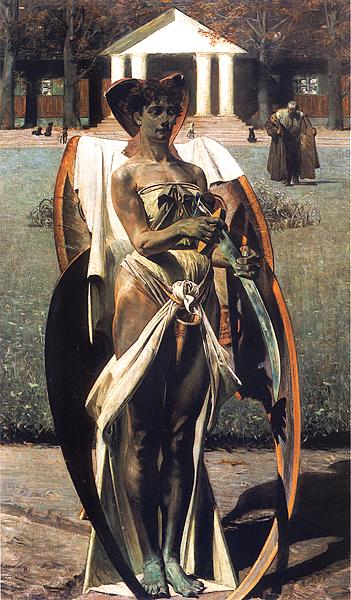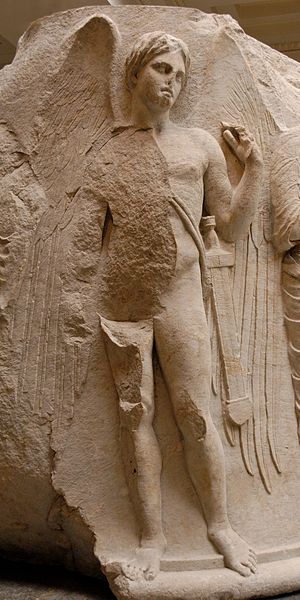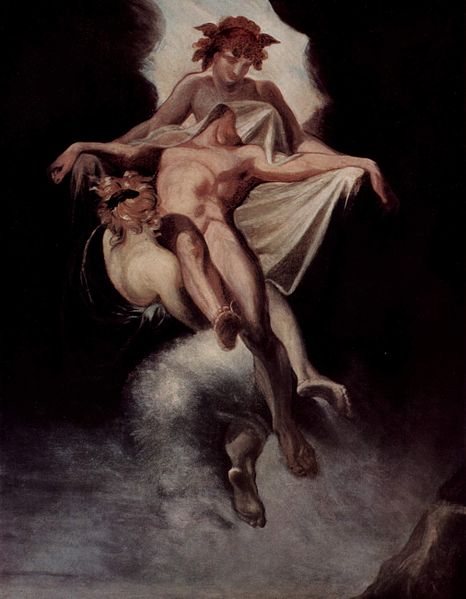One of my favorite activities is researching different mythologies and folklore to see how they describe universal situations such as birth and death. In the case of Greek mythology, the personification of death is Thanatos, a solemn and merciless god who spares no life. Son of Nyx and twin brother of Hypnos, Thanatos was hated by and hateful towards everyone, gods and mortals alike. Let’s explore the story of Thanatos and his ruthless treatment of those who attempted to deceive him.
Thanatos Key Facts
| Parents | Nyx (Night) and Erebus (Darkness) |
| Partners | None |
| All Siblings | Hypnos (Sleep), Moros (Doom) and others |
| Offspring | None |
| Other names | None |
| Roman name | Mors |
| The God of | Non-violent death |
| Symbols | Butterfly, inverted torch, sword |
Name and Etymology
The name “Thanatos” is derived from the ancient Greek word “θάνατος,” which translates directly to “death.” Unlike his Roman counterpart, Mors, Thanatos wasn’t just a concept but a tangible figure in many myths. Throughout various tales, he’s been referred to by epithets that highlight his role as the harbinger of peaceful death, distinguishing him from the violent ends brought about by war and conflict. The Romans, while adopting many Greek deities and myths, saw him in a somewhat different light, often blending the characteristics of both Thanatos and his brother, Hypnos.

Thanatos Origins
Born to Nyx, the primordial goddess of the night, and Erebus, the embodiment of darkness, Thanatos was a part of a unique pantheon of deities that represented various aspects of life and the universe. His siblings included Hypnos, the god of sleep, The Keres, goddesses of violent death, and Moros, the god of doom. These deities, while not as prominent as the Olympians, played crucial roles in the daily lives and beliefs of the ancient Greeks.
There isn’t a specific tale about Thanatos’ birth or childhood, but his essence is as old as time itself. As a personification of death, he existed alongside life, ensuring the balance of the universe. Unlike the grim reapers of other cultures, Thanatos was seen as a merciful figure, ensuring a peaceful transition from life to the afterlife.
His role as a Daemone, or spirit, was to guide souls to the underworld. He wasn’t a god of judgment or the afterlife itself; instead, he was the bridge between life and what came after, working in tandem with his brother Hypnos, who governed sleep.

Thanatos Lovers and Offspring
Interestingly, Thanatos, unlike many of his counterparts in Greek mythology, doesn’t have tales of romantic pursuits or relationships. His nature, representing the end of life, perhaps made him a solitary figure in this regard.
Similarly, there are no myths or tales that speak of any offspring of Thanatos. His role was singular and focused on the act of guiding souls, leaving little room for familial narratives.
Depiction And Characteristics
Thanatos, in many ways, is a paradox. While he embodies the end of life, his portrayal is far from the grim, fearsome figures associated with death in many cultures.
Often depicted as a young man or a beardless youth, Thanatos carries with him symbols that signify his role. He’s frequently shown holding an inverted torch, representing life being extinguished, or a butterfly, symbolizing the soul. Sometimes, he’s also seen with a sword, indicating his authority to sever the thread of life.
The ancient Greeks viewed Thanatos with a mix of respect and apprehension. While he was the inevitable end everyone would face, he wasn’t cruel or malicious. Instead, he was often seen as merciful, ensuring a peaceful transition for souls, contrasting with the violent deaths brought about by war or conflict.
Thanatos Powers
As the god of non-violent death, Thanatos had the authority to claim souls and guide them to the underworld. However, he wasn’t omnipotent. There are tales where he’s been outwitted or restrained, indicating that while he was powerful, there were limits to his influence.
Thanatos Symbols
The butterfly, a delicate and transient creature, is one of the primary symbols associated with Thanatos. Representing the soul, it signifies the fleeting nature of life. The inverted torch, another of his symbols, is a direct representation of life being snuffed out. While there aren’t specific animals or plants tied to him, these symbols provide a profound insight into how the ancient Greeks viewed death and the afterlife.
Thanatos Roles And Responsibilities
In the grand scheme of Greek mythology, Thanatos had a clear and defined role: to guide souls to the afterlife. He wasn’t a judge or a ruler of the underworld; that was the domain of Hades, the god of the underworld. Instead, Thanatos was the gentle hand that led souls from the realm of the living to the realm of the dead.
His responsibilities also included maintaining the balance of life and death. Every being, mortal or immortal, had a predetermined lifespan, and it was Thanatos’ duty to ensure that when their time came, they transitioned peacefully. This role was especially crucial in a culture that believed in fates and prophecies.
Myths about Thanatos
The realm of Greek mythology is vast and intricate, with tales that span from the heroic to the tragic. While Thanatos might not be the central figure in many of these stories, his presence is felt in some pivotal moments, underscoring the inescapable nature of death and the human desire to defy it.

The Cunning of Sisyphus
Sisyphus, the crafty king of Corinth, is perhaps best known for his eternal punishment, but the events leading up to it are a testament to his wit and audacity. When it was foretold that his time on Earth was nearing its end, Sisyphus, not one to accept fate easily, hatched a plan to outsmart death itself.
As Thanatos approached to claim him, Sisyphus feigned a desire to cooperate. He expressed a wish to try out the chains meant to bind him, curious about their strength. Thanatos, perhaps underestimating the cunning of mortals, agreed. But in a swift move, Sisyphus trapped Thanatos instead, rendering him incapable of performing his duties.
With the god of death incapacitated, no mortal could die. Soldiers in battles would fight, fall, and rise again. The elderly who wished for a peaceful end found themselves lingering on. The natural order was in chaos. This disruption caught the attention of Ares, the god of war, who was displeased with the inability to claim the souls of fallen warriors. He intervened, freeing Thanatos and ensuring that Sisyphus would face his due punishment.
For his audacity, Sisyphus was condemned to the depths of Tartarus. There, he was given an eternal task: to push a massive boulder up a steep hill. But every time he neared the top, the boulder would roll back down, forcing him to start over. This endless cycle was a poignant reminder of the futility of trying to cheat death.
The Passing of Sarpedon: A Warrior’s End
In the heat of the Trojan War, as described in Homer’s “Iliad,” many heroes met their end, but the death of Sarpedon, a son of Zeus, The Supreme God, stands out. Not just because of his divine lineage, but because of the profound implications it had on the nature of mortality and the duties of gods.
Sarpedon, a valiant warrior and ally of Troy, met his end at the hands of Patroclus. As he lay on the battlefield, the question arose: What should be the fate of a demigod’s body? Zeus, torn between his paternal love and the natural order of things, decided not to intervene directly. Instead, he entrusted the task of retrieving Sarpedon’s body to Thanatos and Hypnos.
The scene is poignant. As the battle rages on, these two divine entities, representing sleep and death, descend. They gently lift Sarpedon’s body, cleansing it and preparing it for its final journey. This act wasn’t just about honoring a fallen warrior; it was a reminder that death is a great equalizer. Whether mortal or demigod, all must eventually heed its call.
This tale also underscores Thanatos’ role. He wasn’t a vengeful reaper but a guide, ensuring that souls, regardless of their deeds or lineage, found their way to the afterlife. In the grand tapestry of the Trojan War, this moment serves as a somber reflection on the nature of life, death, and the responsibilities even gods must bear.

Thanatos In Ancient Greek Religion
While Thanatos played a significant role in Greek mythology, there aren’t many temples or sites dedicated solely to him. This could be attributed to his somber role, which might not have been celebrated as much as other gods. However, he was often invoked in funeral rites and ceremonies, emphasizing his importance in the journey of the soul.
Representations Of Thanatos In Art
Throughout ancient Greek art, Thanatos is often depicted alongside his brother, Hypnos. They’re usually shown as winged youths, emphasizing their ethereal nature. One of the most notable representations is on the Euphronios Krater, where he’s seen assisting with the body of Sarpedon, showcasing his role in guiding souls.
Mentions in Ancient Texts
The legacy of Thanatos is not just confined to myths and tales; his presence is felt in some of the most seminal works of ancient Greek literature. These mentions not only provide insight into his role but also offer a glimpse into how the ancient Greeks perceived death and the afterlife.
Homer’s “Iliad”
Homer, often considered the greatest of ancient Greek poets, lived around the 8th century BCE. His epic, the “Iliad,” is a cornerstone of Western literature, chronicling the events of the Trojan War. Within its verses, the nature of heroism, fate, and mortality are explored in depth.
In the “Iliad,” Thanatos is not a frequent figure, but his appearances are significant. The most poignant is the death of Sarpedon, a moment that underscores the inevitability of death, even for demigods. As Sarpedon’s life ebbs away on the battlefield, Thanatos, alongside his brother Hypnos, is tasked with ensuring the hero’s body is treated with the respect it deserves. This mention, while brief, serves as a powerful reminder of the transient nature of life and the eternal cycle of death and rebirth.
Hesiod’s “Theogony”
Hesiod, another foundational figure in Greek literature, lived around the same time as Homer, in the 8th or 7th century BCE. His work, “Theogony,” is a narrative of the origins and genealogies of the gods, providing a structured view of the Greek cosmogony.
In “Theogony,” Thanatos is mentioned in the context of his lineage, being born to Nyx (Night) and Erebus (Darkness). The text reads: “And Night bore hateful Doom and black Fate and Death.” This line, while concise, encapsulates the essence of Thanatos. He’s intertwined with concepts like fate and doom, emphasizing his role in the grand scheme of existence.
Through Hesiod’s words, we get a sense of the reverence and apprehension with which the ancient Greeks viewed Thanatos, recognizing his essential role in the balance of life and death.
Frequently Asked Questions
Thanatos is the personification of non-violent death in Greek mythology, ensuring a peaceful transition of souls to the afterlife.
He is the offspring of Nyx, the goddess of night, and Erebus, the embodiment of darkness.
Yes, Hypnos, the god of sleep, is his brother. They often work in tandem, with Hypnos inducing sleep and Thanatos guiding souls.
While he played a significant role in mythology, there aren’t many known temples dedicated solely to Thanatos.
He’s often shown as a young, winged man, sometimes holding an inverted torch or a butterfly.
Unlike many Greek gods, there aren’t tales of romantic pursuits or offspring associated with Thanatos.
Featured Image Credit: Jaime Ardiles-Arce, Public domain, via Wikimedia Commons

